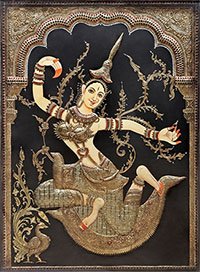Harshashru, Harsha-ashru, Harṣāśru: 5 definitions
Introduction:
Harshashru means something in Hinduism, Sanskrit. If you want to know the exact meaning, history, etymology or English translation of this term then check out the descriptions on this page. Add your comment or reference to a book if you want to contribute to this summary article.
The Sanskrit term Harṣāśru can be transliterated into English as Harsasru or Harshashru, using the IAST transliteration scheme (?).
In Hinduism
Purana and Itihasa (epic history)
Source: archive.org: Shiva Purana - English TranslationHarṣāśru (हर्षाश्रु) refers to “tears of pleasure”, according to the Śivapurāṇa 2.3.53 (“Description of Śiva’s return journey”).—Accordingly, as Menā said to Śiva: “[...] O merciful lord, do mercifully protect Pārvatī. You are quickly pleased. Hence you will please forgive even a thousand faults in her. My dear daughter is devoted to your lotus-like feet in every birth. Even sleeping or awake she does not think about anything else. O conqueror of death, even on hearing about your devotion she is filled with tears of pleasure (harṣāśru) and horripilation. On hearing your censure she becomes silent as though dead”.

The Purana (पुराण, purāṇas) refers to Sanskrit literature preserving ancient India’s vast cultural history, including historical legends, religious ceremonies, various arts and sciences. The eighteen mahapuranas total over 400,000 shlokas (metrical couplets) and date to at least several centuries BCE.
Sports, Arts and Entertainment (wordly enjoyments)
Source: archive.org: Syainika Sastra of Rudradeva with English Translation (art)Harṣāśru (हर्षाश्रु) refers to “tears of joy”, according to the Śyainika-śāstra: a Sanskrit treatise dealing with the divisions and benefits of Hunting and Hawking, written by Rājā Rudradeva (or Candradeva) in possibly the 13th century.—Accordingly, [while discussing the outlines of hawking]: “[...] At times the hairs stand on end, extreme delight is felt, tears of joy flow (harṣāśru), amazement overcomes, the voice gets choked, anxiety, incoherent talk, change of colour and other symptoms of Sattva guṇa (pure emotion) manifest themselves. [...]”.

This section covers the skills and profiencies of the Kalas (“performing arts”) and Shastras (“sciences”) involving ancient Indian traditions of sports, games, arts, entertainment, love-making and other means of wordly enjoyments. Traditionally these topics were dealt with in Sanskrit treatises explaing the philosophy and the justification of enjoying the pleasures of the senses.
Languages of India and abroad
Sanskrit dictionary
Source: Cologne Digital Sanskrit Dictionaries: Cappeller Sanskrit-English DictionaryHarṣāśru (हर्षाश्रु).—[neuter] tear of joy.
Source: Cologne Digital Sanskrit Dictionaries: Monier-Williams Sanskrit-English DictionaryHarṣāśru (हर्षाश्रु):—[from harṣa] n. tears of joy, [Daśakumāra-carita]
Sanskrit, also spelled संस्कृतम् (saṃskṛtam), is an ancient language of India commonly seen as the grandmother of the Indo-European language family (even English!). Closely allied with Prakrit and Pali, Sanskrit is more exhaustive in both grammar and terms and has the most extensive collection of literature in the world, greatly surpassing its sister-languages Greek and Latin.
Kannada-English dictionary
Source: Alar: Kannada-English corpusHarṣāśru (ಹರ್ಷಾಶ್ರು):—[noun] tears caused by great joy.
Kannada is a Dravidian language (as opposed to the Indo-European language family) mainly spoken in the southwestern region of India.
See also (Relevant definitions)
Relevant text
Search found 2 books and stories containing Harshashru, Harṣa-aśru, Harsa-asru, Harṣāśru, Harsasru, Harsha-ashru; (plurals include: Harshashrus, aśrus, asrus, Harṣāśrus, Harsasrus, ashrus). You can also click to the full overview containing English textual excerpts. Below are direct links for the most relevant articles:
Chaitanya Bhagavata (by Bhumipati Dāsa)
Verse 2.107 < [Chapter 2 - The Lord’s Manifestation at the House of Śrīvāsa and the Inauguration of Saṅkīrtana]
Verse 3.4.404 < [Chapter 4 - Descriptions of Śrī Acyutānanda’s Pastimes and the Worship of Śrī Mādhavendra]
Verse 3.6.55 < [Chapter 6 - The Glories of Śrī Nityānanda Prabhu]
Brihad Bhagavatamrita (commentary) (by Śrī Śrīmad Bhaktivedānta Nārāyana Gosvāmī Mahārāja)
Verse 1.4.3 < [Chapter 4 - Bhakta (the devotee)]